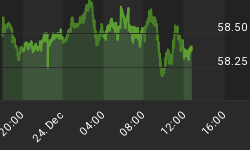M3 died a quiet death this week.
As for whether the Fed's decision to stop reporting its broadest money supply measure was simply a recognition that money has become too complex to quantify, or an attempt to hide the accelerating debasement of the dollar, time will tell. But one thing is certain: The best gauge of gold's near-term direction has now become impossible to calculate. Called the "Fear Index," it was created by GoldMoney's James Turk in the 1980s, and since then it's been nearly flawless (read on for its final prediction). Here's how James and I explained it in our book, The Coming Collapse of the Dollar:
"The dollar is a balance sheet currency, which is to say an accounting fiction. Its value is derived from the assets held by the Federal Reserve and commercial banks, some of which, like gold, are real and tangible, and some, like bank loans, foreign currencies, and derivatives, are not. The Fear Index measures the relative importance of gold within the U.S. monetary system, and is calculated by multiplying the U.S. gold reserve (i.e., the weight of gold reportedly under the Treasury's control) by gold's exchange rate to get its total market value, and dividing this result by M3, the broadest measure of money supply.
A reading of, say, 2%, indicates that for every $100 circulating as M3, there is gold worth $2 sitting in the U.S Treasury's vaults. Gold would thus account for 2% of the dollar's value, with the other 98% dependent upon the financial assets of the Fed and the nation's banks. The calculation for December 31, 2003 is as follows:
When the Fear Index is falling (that is, when the number of dollars in circulation is rising faster than the market value of the gold in U.S. reserves, or when the number of dollars is falling more slowly than the value of the gold reserves) the implication is that people are willing to hold these extra dollars because they're optimistic about the prospects of the dollar and/or the U.S. economy. When the Fear Index is rising (which occurs when money is flowing into gold, pushing up its exchange rate and raising the market value of U.S. gold reserves), it's usually because people are worried about the dollar or the health of the U.S. banking system, and are looking for alternative stores of value.
And when the Fear Index exceeds its 21-month moving average and the moving average rises above its level of the previous month, the result is a 'Buy' signal, indicating that gold is headed higher. As you can see from the chart below, there have been only five such signals in the past thirty-five years, all of which were followed by gold rallies."
Investors who bought gold at the last Fear Index buy signal are up about 80% today. So now the question becomes, where's the top (which is the same thing as asking where the dollar will bottom out). Without the Fear Index--which can't be calculated without M3--this question has become a lot harder to answer. But it's also a long way off. As James wrote in his most recent Freemarket Gold and Money Report newsletter:
"As we can see from the page-1 chart [posted below], the Fear Index has again been climbing over the past few years. There are a couple of noteworthy points to make as a result. There are two solid red downtrend lines on the page-1 chart. Look at what happened after the first downtrend line was broken. The Fear Index soared. Now look at what is happening.
The Fear Index is again soaring, and I expect it to continue climbing higher, repeating the experience of the 1970s. I've drawn two uptrend channels to show that I expect the Fear Index to climb within an uptrend channel just like it did through the 1970s. The second point to which I want to draw your attention on the page-1 chart is the dotted, red downtrend line.
I expect the Fear Index in time to reach and eventually break through that downtrend line. In other words, the Fear Index over the next several years is heading back to - and probably above - 10%. In fact, it is my expectation that within several years, the Fear Index will climb toward the peak reached during the Great Depression. It will do this as the problems with dollar fiat currency become more apparent, causing a flight from the dollar into the safety and security of gold. The flight out of the dollar is already underway. It's only a matter of time before the rush for the exits turns into a torrent.
Assuming M3 grows at 8% a year over the next three years, and the Fear Index rises to 10%, implying that we're worried as in the 1970s, the Fear Index yields a target gold price of $4,961 per ounce."




















